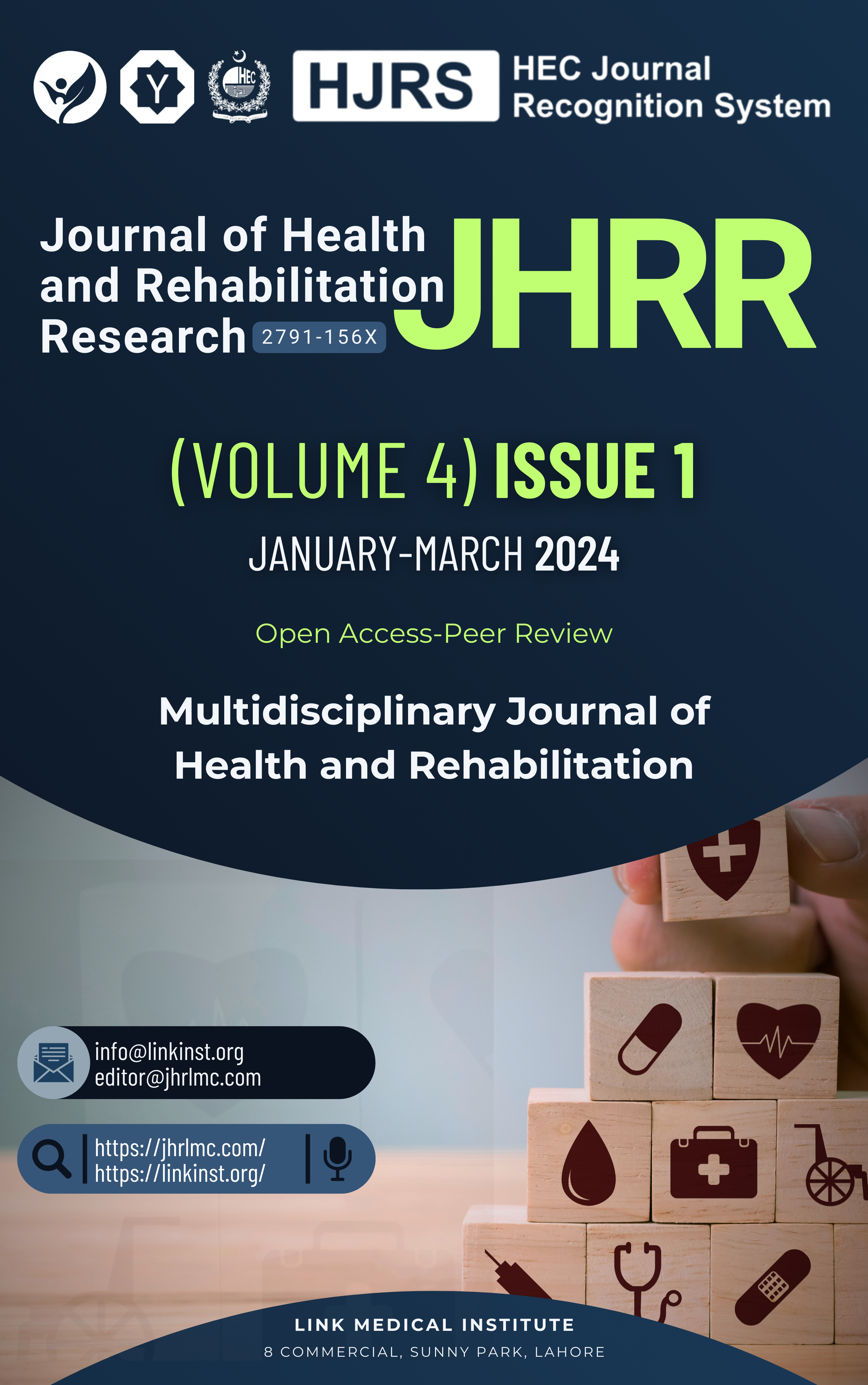Pre-Operative CSF Analysis as a Prognostic Factor for Shunt Infection in Children
DOI:
https://doi.org/10.61919/jhrr.v4i1.324Keywords:
Ventriculoperitoneal shunt, Pediatric hydrocephalus, Shunt infection, Intraoperative CSF sampling, NeurosurgeryAbstract
Background: Ventriculoperitoneal (VP) shunting is a common surgical intervention for pediatric hydrocephalus, yet it is frequently complicated by shunt infections, leading to significant morbidity and mortality. The role of intraoperative cerebrospinal fluid (CSF) sampling in predicting these infections remains unclear, with limited evidence available, particularly in the pediatric population.
Objective: To evaluate the efficacy of intraoperative CSF sampling as a prognostic tool for shunt infections in pediatric patients undergoing VP shunt procedures.
Methods: This prospective study was conducted at Jinnah Post Graduate Medical Centre and included 100 pediatric patients (60% female, 40% male) who underwent VP shunt placement from June to December 2022. Patients with previous cranial surgeries were excluded. Intraoperative CSF samples were analyzed for microbial presence. We assessed patient demographics, clinical conditions necessitating VP shunt, shunt type, and follow-up data, including shunt infection or malfunction incidents. The main outcome measured was the correlation between intraoperative CSF sampling results and subsequent shunt infections, defined as positive culture from CSF or hardware.
Results: During the 6-month follow-up, 20% of the patients required shunt revision, with 5% (5 patients) developing shunt infections. All intraoperative CSF samples were sterile. Infections were predominantly caused by coagulase-negative staphylococcus and occurred despite negative intraoperative CSF results. The infection rate among those who underwent revision was 25%.
Conclusion: The study indicates a lack of correlation between sterile intraoperative CSF samples and the subsequent development of shunt infections in pediatric patients. This finding challenges the necessity of routine intraoperative CSF sampling during VP shunt insertion in the pediatric population.
Downloads
References
Afshari FT, Elawadly A, Thompson DN, Jeelani OUN, Aquilina K. Transcallosal approach and post-operative subdural collections: 12-year paediatric neurosurgery tertiary centre experience. Child's Nervous System. 2023:1-6.
Campbell D, Sinclair S, Cooke D, Webster D, Reid M. The incidence of VP shunt infection in a middle-income nation: a retrospective analysis of a pediatric population. Frontiers in Surgery. 2023;10.
Chia WL, Zaben M, Leach P. Is cerebrospinal fluid sampling necessary at the time of first ventriculo-peritoneal shunt insertion in paediatric patients? Clinical Neurology and Neurosurgery. 2021;204:106608.
Sweeney J, Zyck S, Tovar-Spinoza Z, Krishnamurthy S, Chin L, Bodman A. Evidence-based perioperative protocol for ventriculoperitoneal shunt infection reduction at a single institution. World neurosurgery. 2019;128:e814-e22.
Dhaliwal J, Ruiz-Perez M, Mihaela-Vasilica A, Chari A, Hill CS, Thorne L. Survival and quality of life after CSF diversion in adult patients with leptomeningeal metastasis–associated hydrocephalus: a systematic review and meta-analysis. Neurosurgical Focus. 2023;55(2):E16.
Elmaghrabi MM, Arab AA, Samih TA, Elawady MA, Wahdan MM. Predictors of Endoscopy Success in Treatment of Pediatric Idiopathic Obstructive Hydrocephalus. The Egyptian Journal of Hospital Medicine. 2022;89(1):5123-8.
Enayet AE, Nabil M, Rady MR, Yousef Y, Badawy E, El Beltagy MA. Surgical outcome of children with medulloblastoma: a retrospective study of a 405-patient series from Children’s Cancer Hospital Egypt (CCHE-57357). Child's Nervous System. 2021;37:1931-40.
Ganau M, Magdum SA, Calisto A. Pre-operative imaging and post-operative appearance of standard paediatric neurosurgical approaches: a training guide for neuroradiologists. Translational Pediatrics. 2021;10(4):1231.
Hale AT, Riva-Cambrin J, Wellons JC, Jackson EM, Kestle JR, Naftel RP, et al. Machine learning predicts risk of cerebrospinal fluid shunt failure in children: a study from the hydrocephalus clinical research network. Child's Nervous System. 2021;37:1485-94.
Hani U, Kamran Bakhshi S, Shamim MS. Permanent pre-operative cerebrospinal fluid diversion in paediatric patients with posterior fossa tumours. JPMA The Journal of the Pakistan Medical Association. 2020;70(6):1101.
Kalangu KK, Esene IN, Dzowa M, Musara A, Ntalaja J, Badra AK. Towards zero infection for ventriculoperitoneal shunt insertion in resource-limited settings: a multicenter prospective cohort study. Child's Nervous System. 2020;36:401-9.
McAlpine A, Sauve L, Collet J, Goldfarb D, Guest E, McDonald P, et al. Risk factors for cerebrospinal fluid shunt infections during an outbreak: a case–control study. Journal of Hospital Infection. 2020;105(1):78-82.
Pilotto C, Liguoro I, Scaravetti S, Passone E, D’Agostini S, Tuniz F, et al. Risk factors of persistent hydrocephalus in children with brain tumor: a retrospective analysis. Pediatric neurosurgery. 2021;56(3):205-12.
Rahman MM, Khan SKN, Khan RA, Islam R, Sarker MH. Endoscopic third ventriculostomy in children: problems and surgical outcome: analysis of 34 cases. Chinese Neurosurgical Journal. 2021;7(02):137-42.
Sáenz A, Badaloni E, Grijalba M, Villalonga JF, Argañaraz R, Mantese B. Risk factors for surgical site infection in pediatric posterior fossa tumors. Child's Nervous System. 2021;37(10):3049-56.
Verhey LH, Maharaj A, Patel N, Manoranjan B, Ajani O, Fleming A, et al. External ventricular drainage in the management of pediatric patients with posterior fossa tumors and hydrocephalus: a retrospective cohort study. Child's Nervous System. 2023:1-8.
Youssef EM, Rashed ME, Elsayed BM, El Sheikh MO. Management and Outcome Predictors of Pediatric Cerebrospinal Fluid Shunt Infections. The Egyptian Journal of Hospital Medicine. 2022;89(2):7363-71.
Jakimovski D, Bonci G, Attia M, Shao H, Hofstetter C, Tsiouris AJ, et al. Incidence and significance of intraoperative cerebrospinal fluid leak in endoscopic pituitary surgery using intrathecal fluorescein. World neurosurgery. 2014;82(3-4):e513-e23.
Zhou Q, Yang Z, Wang X, Wang Z, Zhao C, Zhang S, et al. Risk factors and management of intraoperative cerebrospinal fluid leaks in endoscopic treatment of pituitary adenoma: analysis of 492 patients. World neurosurgery. 2017;101:390-5.
Kaptain GJ, Kanter AS, Hamilton DK, Laws ER. Management and implications of intraoperative cerebrospinal fluid leak in transnasoseptal transsphenoidal microsurgery. Operative Neurosurgery. 2011;68:ons144-ons51.
Strickland BA, Lucas J, Harris B, Kulubya E, Bakhsheshian J, Liu C, et al. Identification and repair of intraoperative cerebrospinal fluid leaks in endonasal transsphenoidal pituitary surgery: surgical experience in a series of 1002 patients. Journal of Neurosurgery. 2017;129(2):425-9.
Lobo BC, Baumanis MM, Nelson RF. Surgical repair of spontaneous cerebrospinal fluid (CSF) leaks: a systematic review. Laryngoscope investigative otolaryngology. 2017;2(5):215-24.
Downloads
Published
How to Cite
Issue
Section
License
Copyright (c) 2024 Yousra Hatif Farooqi, Iram Bokhari, Tehniat Khaliq

This work is licensed under a Creative Commons Attribution 4.0 International License.
Public Licensing Terms
This work is licensed under the Creative Commons Attribution 4.0 International License (CC BY 4.0). Under this license:
- You are free to share (copy and redistribute the material in any medium or format) and adapt (remix, transform, and build upon the material) for any purpose, including commercial use.
- Attribution must be given to the original author(s) and source in a manner that is reasonable and does not imply endorsement.
- No additional restrictions may be applied that conflict with the terms of this license.
For more details, visit: https://creativecommons.org/licenses/by/4.0/.






